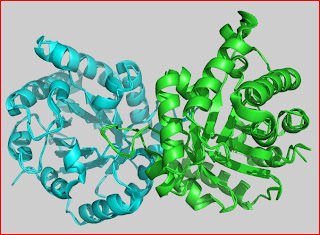 |
| Figure 1. Glycolysis pathway highlighting TIM role (Figure 14-2 from Leighner) |
 |
| Figure 2. Isomerization reaction by TIM from SigmaAldrich |
 |
| Figure 3. Enediolate and sulfate bound to Triose phosphate isomerase (3PY2) |
Lack-of-function mutations (most commonly E104D) cause a serious, progressive, neurological disease creatively entitled triose phosphate isomerase deficiency...yep, creative. The most common characteristic of this disease is hemolytic anemia--the abnormal breakdown of red blood cells.
Trypanosoma brucei, the parasite that causes African sleeping sickness, also has this enzyme. However, it has an extra 22-amino acid fragment that is unique. It has been found to send responder signals to glycosomes: a subset of peroxisomes. This same TIM protein with the extra 22-amino acid fragment was put into a similar organism and it did not target the glycosomes. This presents a potential drug target for African sleeping sickness. It is, quite surprisingly, found in an enzyme shared by most organisms.
Resources:
Galland, N., de Walque, S., Voncken, F.G., Verlinde, C.L., Michels, P.A. “An internal sequence targets Trypanosoma brucei triosephosphate isomerase to glycosomes” Mol Biochem Parasitol 171.1 May (2010): 45-49. Medline. Wed. 28 Apr. 2011.
Orosz, F., Oláh, J. and Ovádi, J. (2006), Triosephosphate isomerase deficiency: Facts and doubts. IUBMB Life, 58: 703–715. doi: 10.1080/15216540601115960
Wierenga, R K., E G. Kapetaniou, and R Venkatesan. "Triosephosphate isomerase: a highly evolved biocatalyst." Cell Mol Life Sci67.237 Aug. (2010): 3961-82. Medline. Web. 28 Apr. 2011.





